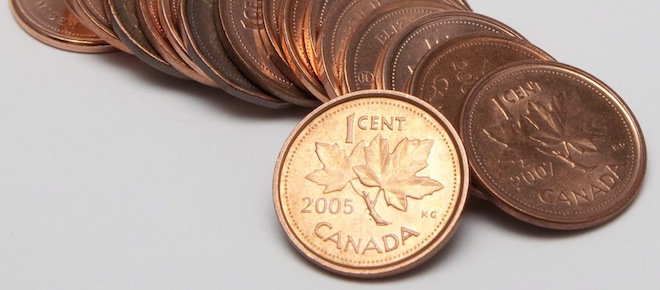So long, penny. Why don’t you take the nickel and the dime with you, too?
Useless change goes beyond the one-cent coin
Canadian pennies are shown in Vancouver, Wednesday, May 26, 2010. Politicians are meeting Wednesday night to hash out the costs and benefits of abolishing the copper coin altogether. THE CANADIAN PRESS/Jonathan Hayward
Share

The Royal Canadian Mint is finally beginning its phase-out of the penny today — and not a minute too soon.
The penny hasn’t made a lick of sense since penny candy started costing more than one cent — and that was before Lester Pearson became prime minister. It’s been costing taxpayers more than its face value to produce since the 1980s.
So good riddance to the feckless penny. Now the Mint should seriously think about getting rid of a couple of other coins that have outlived their usefulness — the nickel and the dime.
Why? Because a century of inflation has robbed them of intrinsic value.
According to the Bank of Canada’s inflation calculator, the Canadian dollar of 1914 had the purchasing power of about $20 in today’s dollars. So a penny then had the purchasing power of 20 cents today. Likewise, a nickel had roughly the same value as a dollar today and having a dime in your pocket a century ago was the same thing as having a toonie now.
The humble penny may have had even more worth back then than the Bank of Canada gives it credit for. Consider that 100 years ago most daily Canadian newspaper cost one cent. The price in competitive Toronto did not rise to two cents until 1917 and that new price held for more than 20 years. Compare that to what you pay for a newspaper today and you get some sense of the real worth of a penny a century ago.
So the penny, nickel and dime were all useful, valuable coins — 100 years ago. Today they just wear needless holes in your pocket or collect in a jar.
Inflation cut the value of the Canadian dollar (and penny) by almost 40% during World War I, the Depression brought it back up in the 1930s (because fewer people had dollars or even dimes in their pockets). World War II kickstarted the economy again but the resulting inflation — and deficit spending — put Canadian currency on a downward spiral from which it has never recovered (despite a much slower rate of decline since the mid-’80s).
By 1948 the dollar (and thus the penny, nickel and dime) had only half the purchasing power it had in 1914. By 1973 the dollar’s purchasing power was only one-quarter of what it was in 1914. And by 1983, a dollar had only one-tenth of its 1914 purchasing power. In the following 30 years of constant (if much-reduced) erosion, the dollar’s real value has declined to only half of what it was even back in inflation-ravaged 1983.
To put this all into perspective, consider the following: If a 1914 penny was worth the equivalent of 20 cents in today’s money and the penny was the smallest coin in use, then Canadian society and business got along just fine without any coins below the equivalent of 20 cents in today’s money.
Not only was there no equivalent of today’s penny, there was no equivalent — or apparent need — for the current nickel or dime either.
New Zealand killed its five-cent coin (worth about four Canadian cents) in 2006 and its economy — and consumer spending habits — haven’t missed a beat. Australia got rid of its one- and two-cent coins way back in 1991 and has been considering eliminating its five-cent coin since seeing New Zealand’s successful downsizing.
Granted, Canada may have a bit more of an emotional attachment to the nickel than others countries since, for much of the 20th Century, we were the only nation in the world to make our “nickels” from pure (well, 99.9 per cent pure) nickel right out of the Canadian Shield.
But those days are long gone. Now the Canadian “nickel” — like our dime, quarter and 50-cent piece — is a slug of steel plated in a copper-nickel alloy. So forget the emotional attachment. And, like the penny, the nickel is fast closing in on the point in time when it will cost more to produce than its worth, even though it’s now 94.5 per cent steel.
Let’s just accept the fact that the nickel should go the way of the penny — into oblivion.
Former Bank of Canada economist Jean-Pierre Aubry was advocating the abolition of the penny a decade before its actual demise. Now he has his sights set on the nickel because it too is getting too expensive to produce and people just aren’t using the coin much anymore.
“We see less and less people now … digging in their wallets for nickels,” Aubry told the Canadian Press recently. “It’s a sign that the coin is not well used.”
As for the dime, well, that may be a harder sell. There could be complications arising from a currency in which the smallest coinage is 25 cents, even though inflation will continue to gnaw away at the real purchasing power of the dollar and its sub-units.
No economist is seriously recommending the demise of the dime — yet.
But inflation’s creep is inexorable and the dime’s day of reckoning is inevitably coming — perhaps not in this decade, but in the foreseeable future. After all, 10 cents today is only worth the equivalent of half a penny in 1914. And even then Canadians knew better than to have a half-penny cluttering up our currency and wearing holes in our pockets.
It’s time to nuke the nickel and start the countdown for the detonation of the dime. Either that or we’ll be nickeled and dimed to death.